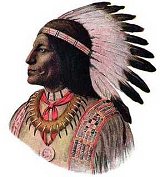

 |
| Chief Pontiac |
During the war, the British under Major Robert Rogers were advancing on Fort Detroit. Rogers intended to lead his 60 rangers to Fort Detroit along the southern shore of Lake Erie. When he reached the Cuyahoga River, some Ottawa under the leadership of Chief Pontiac met him. Pontiac was allied with the French and warned Rogers to turn back and not come through their land.
Despite the warning, Rogers continued on and eventually captured Fort Detroit for the British. This angered Chief Pontiac. He vowed that he would drive the British from the Ohio territory.
In 1762 Chief Pontiac was able to join together most of the area's Indian tribes in the first of two great Indian confederacies. The Indians, under Pontiac's leadership, captured 9 of the 11 British forts in the Ohio Valley. Only Detroit and Pitt remained in British control.
Pontiac laid siege to Fort Detroit and another Indian army (partially led by the Shawnee Chief Cornsalk and accompanied by Pucksinwa) laid siege to Fort Pitt.
After the Treaty of Paris, the French withdrew their support of Pontiac. He was forced to abandon the sieges and retreat to the Maumee Valley.
Colonel John Bradstreet requested a meeting with the Indian leaders at Fort Detroit to talk peace. No significant chiefs showed up. In response, Colonel Henri Bouquet advanced on the Delaware and ordered them to gather the chiefs of the other tribes for peace talks. Bouquet threatened to burn the Delaware village if they refused to comply with his instructions. The chiefs acquiesced and signed the treaty of Fort Pitt in 1764.
Terms of the treaty included recognizing British control over the Ohio territory. The British also issued the Proclamation of 1763 instructing all British subjects to stay east of the Allegany Mountains and all Indians to stay west.